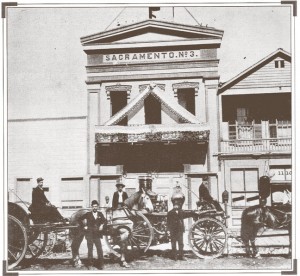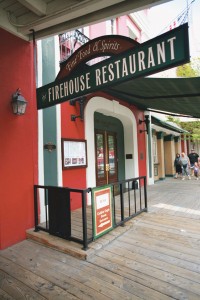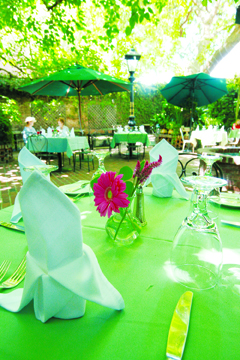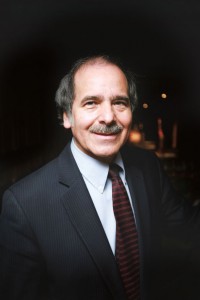The Firehouse
Posted on May 3, 2011 – 6:55 AM | by AdminBy Sarah Singleton Photos by Scott Duncan
The Firehouse has long been an oasis of good taste in the kitsch desert that is Old Sac. Even walking the few blocks from the parking garage is a little surreal. Try not to get your fancy high heel stuck in the wooden sidewalks as you gawk at the souvenir t-shirts, the multiple barrels of salt-water taffy and touristy bar after touristy bar. Soon enough you will reach the welcoming double doors of The Firehouse restaurant, a stately old gem that at one time was at risk of demolition to make room for a freeway.
 In 1959, the “West End” of Sacramento, or riverfront area, was a slum. Boasting more transients per capita than viable businesses, it was here that Newton Cope took a chance on the old firehouse #3. Built in 1853, it was long vacant and slated for demolition. These days it’s a National Historic Building. Cope first opened a bar, and then began serving sandwiches for patrons who arrived hungry. Around town, interest gathered in this joint down by the river….even down at the Capitol. One night Mr. Cope found a limousine waiting outside—it was then-governor Pat Brown at the door, wondering if he might get a late-night bite to eat. Current owner Lloyd Harvego tells me it wasn’t long after that the Firehouse began offering a full-service menu.
In 1959, the “West End” of Sacramento, or riverfront area, was a slum. Boasting more transients per capita than viable businesses, it was here that Newton Cope took a chance on the old firehouse #3. Built in 1853, it was long vacant and slated for demolition. These days it’s a National Historic Building. Cope first opened a bar, and then began serving sandwiches for patrons who arrived hungry. Around town, interest gathered in this joint down by the river….even down at the Capitol. One night Mr. Cope found a limousine waiting outside—it was then-governor Pat Brown at the door, wondering if he might get a late-night bite to eat. Current owner Lloyd Harvego tells me it wasn’t long after that the Firehouse began offering a full-service menu.
 At the beginning, the Firehouse was designed as an upscale steakhouse. A filet mignon dinner and a bottle of ’56 Krug cabernet would set you back all of $10 in the mid sixties. As the decades have rolled on, the menus have evolved. Those ‘60s upscale steaks turned into ‘70s Continental fare and an extensive tableside service menu (gone today due to updated fire codes). The ‘80s and ‘90s brought more nouveau interpretations of classic cuisine. Today’s menus are quite modern, but with just a nod to classic dishes. Former Firehouse chef Raymond Salladarre and current general manager and sommelier Mario Ortiz agree: The Firehouse has consistently bought the best products available, but more recently, a greater availability of products and a wider range of culinary knowledge (of both chef and customer) afford chefs more creative license for experimentation while keeping the restaurant’s roots traditional.
At the beginning, the Firehouse was designed as an upscale steakhouse. A filet mignon dinner and a bottle of ’56 Krug cabernet would set you back all of $10 in the mid sixties. As the decades have rolled on, the menus have evolved. Those ‘60s upscale steaks turned into ‘70s Continental fare and an extensive tableside service menu (gone today due to updated fire codes). The ‘80s and ‘90s brought more nouveau interpretations of classic cuisine. Today’s menus are quite modern, but with just a nod to classic dishes. Former Firehouse chef Raymond Salladarre and current general manager and sommelier Mario Ortiz agree: The Firehouse has consistently bought the best products available, but more recently, a greater availability of products and a wider range of culinary knowledge (of both chef and customer) afford chefs more creative license for experimentation while keeping the restaurant’s roots traditional.
 Wine selection has also long been part of the Firehouse legacy. Wine lists of the past were limited—as were those of most restaurants of the United States at the time. But, as the wine business in California grew, so did the wine cellar – and wine director Mario Ortiz’ thirst for knowledge. From the beginning, the Firehouse has cellared selections from both California and from France: Chateaus Margaux and LaTour were available alongside Paul Masson and Robert Mondavi. By the late seventies, the Firehouse had begun a serious reinvention of their wine list, beginning with the wines by the glass. No more cheap Chablis, the Firehouse staff instead began to educate the public about the wonderful Chardonnays that were being produced in the nearby Napa valley.
Wine selection has also long been part of the Firehouse legacy. Wine lists of the past were limited—as were those of most restaurants of the United States at the time. But, as the wine business in California grew, so did the wine cellar – and wine director Mario Ortiz’ thirst for knowledge. From the beginning, the Firehouse has cellared selections from both California and from France: Chateaus Margaux and LaTour were available alongside Paul Masson and Robert Mondavi. By the late seventies, the Firehouse had begun a serious reinvention of their wine list, beginning with the wines by the glass. No more cheap Chablis, the Firehouse staff instead began to educate the public about the wonderful Chardonnays that were being produced in the nearby Napa valley.
The Firehouse’s cellars exploded in the late ‘90s—going from a restrained 3000 bottles to their current whopping 28,000 bottles. There are two temperature, humidity and light-controlled cellars to house the massive collection. Something new in the wine cellar is the Firehouse’s own label, called simply Firehouse #3. It’s a cabernet blend made with grapes grown in the Napa Valley, crafted by Ortiz and Paul Marsh, the sommelier who typically leads the “Wine Tasting Tuesday” series at the restaurant. The two are currently plotting the next blends, one red and one white.
 What separates good restaurants from great restaurants is, quite simply, service. Since 1960, the level of service provided to their customers, whether regulars or people who come by once or twice—is top notch. Professional, unobtrusive, yet helpful and friendly—that’s quite a balancing act and can totally change your experience as a diner. At the beginning, Newton Cope, who owned a Buick dealership in town, was a talented marketer and knew treating customers like they were special was the way to win return business. Mario Ortiz, who has worked at the Firehouse for the past 40 years, feels privileged to carry on that tradition. ”It’s exciting for me to meet new customers and make them feel welcome. I love introducing them to new things.”
What separates good restaurants from great restaurants is, quite simply, service. Since 1960, the level of service provided to their customers, whether regulars or people who come by once or twice—is top notch. Professional, unobtrusive, yet helpful and friendly—that’s quite a balancing act and can totally change your experience as a diner. At the beginning, Newton Cope, who owned a Buick dealership in town, was a talented marketer and knew treating customers like they were special was the way to win return business. Mario Ortiz, who has worked at the Firehouse for the past 40 years, feels privileged to carry on that tradition. ”It’s exciting for me to meet new customers and make them feel welcome. I love introducing them to new things.”
What also separates a good restaurant from a great one is the staff. It’s nearly unheard of in the States to have career front-of-the-house staff. Ortiz has been at the Firehouse now for most of his life, working his way up from busboy to his current position as General Manager. Former chef Salladarre remarked “I couldn’t have done it without the great and talented staff they have there.” All involved seem genuinely dedicated to the work that they are doing.
What keeps a restaurant like this viable for so long? Why do customers keep coming back? Is it the food? Is it the wine? The staff? Celebrity sightings? I asked this time and again and got similar answers from Mr. Havrvego, Mr. Ortiz and Mr. Salladarre: It’s the way the Firehouse treats its customers. Long-time customers, new customers, occasional diners, people who stop by for a drink. Treating customers as valued guests is the key to their long-term success. It never goes out of style.
The Firehouse Restaurant,
1112 Second Street, 916-442-4772,
www.firehouseoldsac.com
Tags: Firehouse Restaurant



One Response to “The Firehouse”
By Elsa Rowan on May 7, 2011 | Reply
This article is not only absurdly inaccurate, but an insult to the talent that is CURRENTLY behind the amazing food and wine program at The Firehouse. A poorly written article, I am shocked Ms. Singleton did not properly do her research before writing such a travesty. The Chef mentioned, is not the current Executive Chef, but was employed during the 1980’s when the food was at its lowest point in taste and quality. Executive Chef Deneb Williams has transformed the cuisine and Sommelier Paul Marsh is the driving force behind the cult wines, The Firehouse brand, and new trends currently happening in the world of wine. Why these two were not even mentioned is a insult to all of the outstanding work these gentlemen bring to this establishment. I look forward to see the retraction of Ms. Singleton’s article, with mention of the current driving force of The Firehouse.